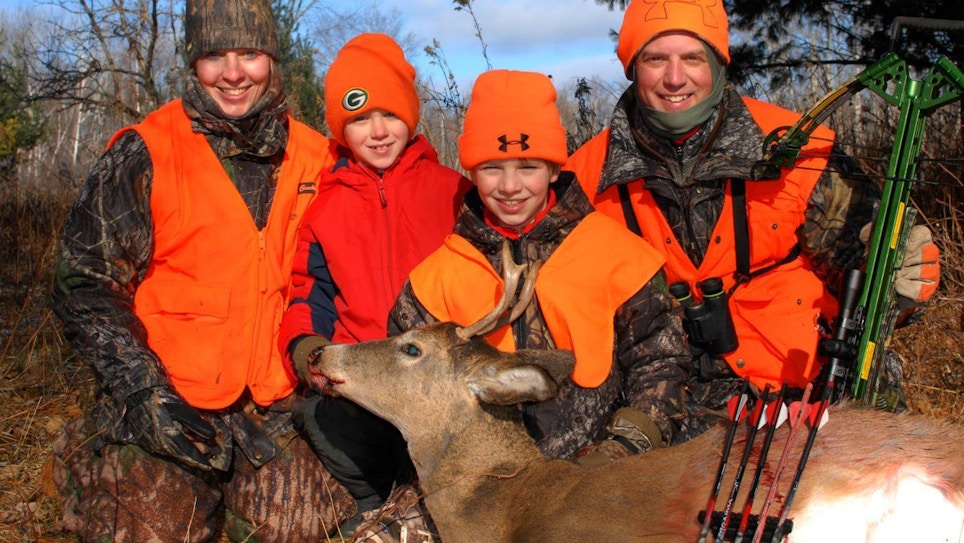
For many bowhunters, antler score is the barometer for success. In the author’s opinion, that’s sad. In the above photo, a young hunter proudly holds his first buck while his family shares in his excitement.
On a bowhunt in South Africa a few years ago, I saw something that got me thinking about why we — or should I say, I — hunt. A rifle hunter was in camp with his wife as an observer. He was a relatively new hunter, and it was obvious from our conversations that we were there for different reasons. He was hunting plains game, and when he shot a Cape bushbuck — one of the coolest animals I have ever hunted — his first comment, when we walked up to the animal, was, “Does it make the book?” When the guide told him it was a superb specimen but that it probably would not, because record book bushbuck are exceedingly hard to come by, he was actually disappointed.
Here was a man who was, for all intents and purposes, a novice hunter and he was worried about putting animals in some record book? Seriously?
I thought to myself, this poor chap has set himself up for failure. He had never even seen a bushbuck before, knew nothing at all about them, and he was unhappy that this one didn’t make “the book?” He thought he was in competition with hunters he’ll never meet to judge animals not as the magnificent creatures they are, but to see how many he can put in some record book. And then I got to thinking, when did hunting become a competition with other hunters?
Please don’t misunderstand. I love competition in life. Being competitive helps you become the best you can be at whatever it is you’re trying to accomplish. I’ve never believed in participation ribbons or bonuses for just showing up. What I have always believed in is striving, every day, to make yourself a little bit better with the goal of becoming the best you can be given the limits the good Lord placed on your inherent talents.
When I started hunting as a kid, I didn’t even know record books existed. We were meat hunters, pure and simple. It wasn’t until I got my first job as an outdoor writer in my late 20s that I learned about record books. Then, as now, I never really cared about them all that much. I’d score animals I killed and use those scores in articles, but only as a way to help explain a buck’s or bull’s size and age, not as a way to measure my prowess as a woodsman. When it comes to hunting, the only person I’m in competition with is myself.

The granddaddy of record books in North America is the Boone & Crockett Club. It all began back in the 1920s in response to public interest generated by the club’s National Collection of Heads and Horns, when the club established an official measurement and scoring system for trophy big game. The National Collection and the measurement system were initially conceived to record species of North American big game thought to be vanishing. Club members and others in the scientific community soon recognized that the system was an effective means of tracking the success of new conservation policies. The first formal recognition of outstanding North American big game trophies by the club was in the 1932 records book. It involved relatively few specimens that were listed by simple criteria of length and spread of horns, antlers or skulls. The club maintains these as a vital conservation record in assessing the success of wildlife management programs, not as a reward for some perceived competition between hunters.
Likewise, the Pope & Young Club’s records program archives provide great insight into the past and present management, health and trends of North America’s wildlife populations and bowhunting opportunities. The records are, first and foremost, a testimonial to wildlife, traditional wildlife management and the importance and success of hunting as a management tool.
Mother Nature has always fascinated me. Every time I step outside, I notice something new. As a hunter, I’ve always wanted to learn as much as I could about the animals I pursue. Why do they do what they do, live where they live, and eat what they eat? How do their habits and preferred habitats differ in different parts of their overall range? What outside influences, like weather, increased predator activity, or human encroachment, make them change their usual habits? It is this, and so much more, that keeps me going to the woods — not an obsession with record books. These days the competition, for me at least, is about hunting older animals, not necessarily the ones with the largest antlers, horns or skulls. Over the years I’ve shot several animals that would qualify for both the B&C and P&Y record books, but I’ve entered only one, an Alaska grizzly bear an outfitter friend of mine asked me to enter to help promote his business.
What about local big buck contests and similar events? I do enjoy them. They’re fun, often support charity and help promote local camaraderie and pride. Sure, at times there can be some cheating, but that’s the case with everything in life these days, it seems. And really, in the long run the people who are cheated the most are the cheaters themselves.
What about you? Are you in competition with other hunters, or yourself? Why do you hunt? What about contest hunting? Drop me a note at editor@grandviewoutdoors.com and let me know your thoughts, I’d love to hear from you.





